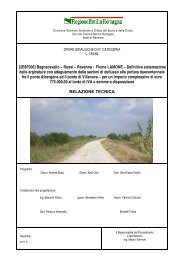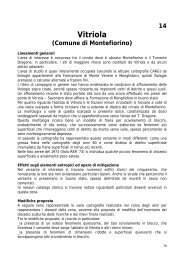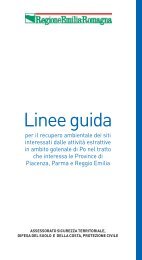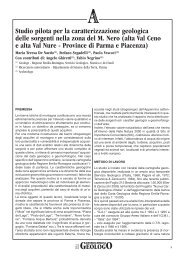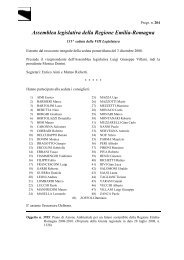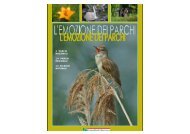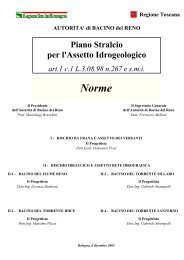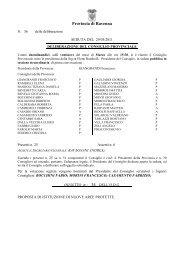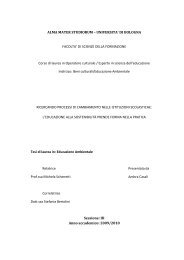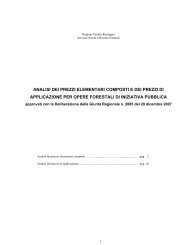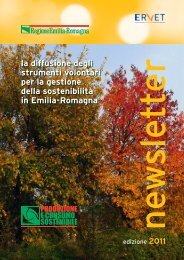air, water and soil quality qualité - ER Ambiente - Regione Emilia ...
air, water and soil quality qualité - ER Ambiente - Regione Emilia ...
air, water and soil quality qualité - ER Ambiente - Regione Emilia ...
You also want an ePaper? Increase the reach of your titles
YUMPU automatically turns print PDFs into web optimized ePapers that Google loves.
Glyphosate is not equally retained by the <strong>soil</strong> <strong>and</strong> can be dispersed with run off<br />
up to 45% of the applied amounts.<br />
No tillage plots show a much higher concentration of glyphosate in run-off than<br />
conventional tillage. However, the total sum of glyphosate in run off was higher on<br />
conventional tillage on Pixendorf site where the high infiltration capacity of the no<br />
tillage plots prevented the run off. On the Kirchberg site the crusted <strong>soil</strong> surface<br />
caused the high run off as well as corn crop cover.<br />
For drawing final conclusions about the risk of glyphosate dissipation through<br />
erosion processes, not only the classical erosion parameter must be considered, e.g.<br />
erosivity of rain, erodibility of the <strong>soil</strong>, slope, <strong>soil</strong> constituents etc., but even more<br />
the actual structural status of <strong>soil</strong>, like pore size distribution, infiltration rate, hydraulic<br />
conductivity, <strong>and</strong> particular crop protection practices like mulching.<br />
The tillage Pesticide residues in the bottom sediments of the surface <strong>water</strong> systems<br />
may be influenced by a number of factors including runoff potential <strong>and</strong> intrinsic<br />
properties of the pesticides (Krueger et al., 1999)<br />
Dispersion<br />
Solid particles adsorption<br />
Aggregates adsorption<br />
Risk for surface <strong>water</strong> systems!<br />
(Eriksson et al., 2007, Warren et al, 2003; Krueger et al., 1999; Peruzzo et al.,<br />
2008; Warnemuende et al., 2007; Siimes et al., 2006; Widenfalk et al., 2007)<br />
Leaching-preferential flows. The sources <strong>and</strong> transport routes of pesticides to<br />
ground<strong>water</strong> are multifaceted. They can include non-point sources such as agriculture,<br />
with pesticide leaching from top <strong>soil</strong> via:<br />
Matrix-flow in s<strong>and</strong>y aquifers<br />
Preferential flow or macropore flow in eg tills<br />
Surface <strong>water</strong> recharge of ground<strong>water</strong> through “leaky streams”<br />
Soil cracks<br />
Intra-aggregate pores<br />
Inter-aggregate pores<br />
In the study of Rueppel ML et al., (1977), glyphosate was considered as pesticide I<br />
class <strong>and</strong> thereby posses no propensity for leaching. On the other h<strong>and</strong>, in certain<br />
<strong>soil</strong>s <strong>and</strong> under different conditions, there is a risk for ground<strong>water</strong> contamination<br />
as it is shown in some other investigations (Albrechsten et al., 2001; L<strong>and</strong>ry et al.,<br />
2005; Papiernik SK, 2001; Stenrød M et al., 2007). Degradation potential of pesticide<br />
is lower in aquifers than in top <strong>soil</strong>.<br />
Influence of glyphosate on shallow aquifers/aquatic/marine ecosystems. Influence<br />
of glyphosate on different <strong>water</strong> organisms in <strong>water</strong> systems was already in<br />
various investigations shown (Warren et al., 2003;Feng et al., 1990; Tsui <strong>and</strong> Chu,<br />
2007; Peruzzo et al., 2008; Amorós et al., 2007; Widenfalk et al., 2007). There is<br />
still a need for more data for better underst<strong>and</strong>ing the influence <strong>and</strong> behavior of<br />
108



